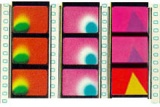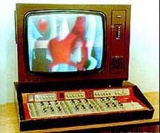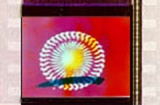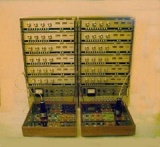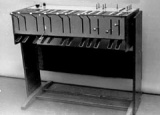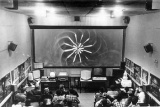Prometheus
“If there are extraterrestrials making art, it’s most likely music for the eyes because, unlike sound, light travels everywhere,” said Bulat Galeyev, who spent many years at the head of the Prometheus research group affiliated with the Aeronatics Institute in Russia’s Kazan. While there wasn’t a single employee of the experimental laboratory with a background in art, today the films, video-installations and performances created by the group are considered pioneering works of media art and video art. The group, with Galeyev at the helm, constructed devices that allowed for the integration of music with visual effects. It also created industrial-scale machines for the production of light performances in the public space.
Prometheus was born in a student dormitory at the Technical University, where two students Oleg Shornikov and Constantine Vasiliyev organized an audiovisual concert of A. N. Skriabin’s V Symphony, titled Prometheus: The Poem of Fire, Op. 60. The composition reflected the composer’s pursuit of a multi-sensory experience, which he likened to a religious epiphany (Skriabin died in 1915). Shornikov and Vasiliyev built a huge cardboard hemisphere in the school’s halls, equipped with a system of colored lights that was hooked up to a device that synchronized their lighting with the rhythm of the music. The concert was a great success and students who were interested in continuing their research on the integration of light and sound were provided their own space. Shortly thereafter, a graduate from the department of math and physics, named Bulat M. Galeyev, joined them and shot up to Prometheus’ leader.
The fundamental aspect their research focused on was synthesis, which made experiences that acted upon one particular sense perceptible to the other senses. This is why Galeyev, in creating his visualizations, never treated them as an accompaniment to sound, but as an equal medium for generating sensory experiences of a composition. A key inspiration for the group’s experiments came through Wassily Kandinsky’s abstract paintings. While soviet propaganda derided non-figurative art, its distaste could be mitigated by emphazing the scientific and technical aspects of these activities. Galeyev would often repeat that Prometheus was only partly functioning underground, as these works were produced under the auspices of the government, not in small, dark cellars. In spite of this, experiments needed to be legitimized, which is why the Prometheus group realized such projects as the light installation fixed to the tower of the citadel in Kazan, which turned on the moment the bells began to sound, or a light system on the circus top which responded to changing weather conditions.
The group developed various music-light instruments, including Prometheus-1 (1962; used to conduct the first in USSR performance of Scriabin's Prometheus, including lighting part in author's transcription)[1], Prometheus-2 (1963; used in 1963-1964 to perform visuals to the music by A.N.Scriabin, M.P.Musorgsky, N.A.Rimsky-Korsakov, I.F.Stravinsky, F.Z.Yarullin)[2], Crystall (1966; used in 1966-1970 to perform visuals to the compositions Dark Flame by A.N.Scriabin, The Structures by P.Boulez, The Tears by A.Nemtin, The Firework by K.Debussy)[3], and Prometheus-3[4].
The most remarkable device designed by the group’s researchers was the Man-Machine, which was meant to monitor the activity of various types of electrical systems, from assembly lines in factories to rocket ships. When everything was functioning correctly, the screen would show a luminescent visualization that was set to music. If there was a glitch, the screen changed to a red, pulsating surface set to an unpleasant sound. Some of the experimental films produced by Prometheus, such as the ten-minute-long Little Triptych, were screened in cinemas and on television inbetween shows. It was preceded by an announcement that the projection isn’t a work of abstract art, but a demonstration of the possibilities offered by new soviet technology. After the fall of communism, the members of Prometheus intensively explored the potential of disco spaces, even to the extent that they published a handbook titled Discotheque Technology. After Galeyev’s death in 2009, the laboratory began to function as an institute of functional semiotics, dropping its research into audiovisual art. (Source)
Works[edit]
fragment from the concert using Crystall
fragment from the concert using Prometheus-2
Crimson Chime installation in Spasskaya Tower of Kazan Citadel, 1967
The system of dynamical lighting of Kazan Circus, 1968
fragment from the light-music film Eternal Movement, 1969
The light-musical panel Singing Cosmos, 1970
fragment from the light-music film Space Sonata, 1981
fragment from the light-music video The Temple (in the kitsch-style), 1989
fragment from the light-music video Dance of Vertical Lines, 1990
Collective self-portrait of Prometei institute, 1994
Russians Leave Europe, video installation, 1995
Electronic Court, video installation
Electronic Grimases in the Magnetic Field, video installation
TV Set Playing the Piano, video installation
The Op Art of Video Art, video installation
Notes[edit]
Publications[edit]
- B. M. Galeyev, "Music-Kinetic Art Medium: On the Work of the Group 'Prometei' (SKB), Kazan, U.S.S.R.", Leonardo, Vol. 9, No. 3 (1976), pp 177-182.
- Paulo Quadros, "Synaesthesia - The Correspondences Between Sound and Light and Colour-music (Skb Prometei)", 1984.
- B. M. Galeyev, "The Fire of "Prometheus": Music-Kinetic Art Experiments in the USSR", Leonardo, Vol. 21, No. 4 (1988), pp 383-396.
- B. M. Galeyev, "Light-Music Today: The development of Scriabin's Ideas (on the example of Kazan school of new art)", Transactions of Scriabin Museum, Moscow, 1998, No 3, pp. 52-71.
- B. M. Galeyev, "Institute "Prometei", Kazan, Russia (1962-1997)" 1997.
- Bulat Galeyev's bibliography on Monoskop
- Bibliography of 'Prometheus' books (1967-1999)
Literature[edit]
- Brian Droitcour, "The Prometheus Institute and the Work of Bulat Galeyev" 2009.
- http://remakebrno.tumblr.com/post/24128598004/interview-with-icelandic-part-of-remake-exhibition
See also[edit]
Links[edit]
- http://prometheus.kai.ru/
- Soviet videocube (Kazan, 1980) connecting Thereminvox
- Lucid Light Comp. #2, a dynamic installation inspired by ideas and aesthetics of Galeyev and Prometheus Institute, part of the Remake project in Brno, Czech Republic, 2012.
- http://cdm.link/2017/02/enter-trippy-fanciful-world-soviet-light-art-studio-prometheus/


